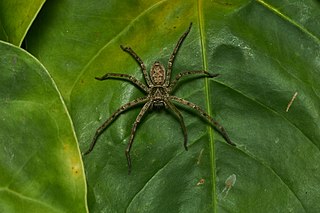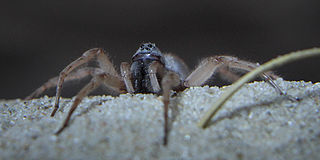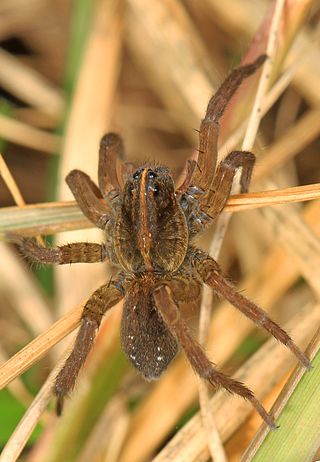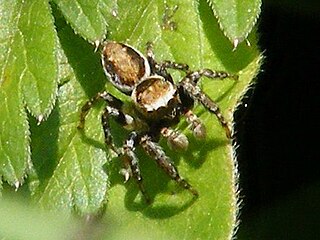
Wolf spiders are members of the family Lycosidae, named for their robust and agile hunting skills and excellent eyesight. They live mostly in solitude, hunt alone, and usually do not spin webs. Some are opportunistic hunters, pouncing upon prey as they find it or chasing it over short distances; others wait for passing prey in or near the mouth of a burrow. Wolf spiders resemble nursery web spiders, but wolf spiders carry their egg sacs by attaching them to their spinnerets, while the Pisauridae carry their egg sacs with their chelicerae and pedipalps. Two of the wolf spider's eight eyes are large and prominent; this distinguishes them from nursery web spiders, whose eyes are all of roughly equal size. This can also help distinguish them from the similar-looking grass spiders.

Heteropoda venatoria is a species of spider in the family Sparassidae, the huntsman spiders. It is native to the tropical regions of the world, and it is present in some subtropical areas as an introduced species. Its common names include giant crab spider, pantropical huntsman spider or cane spider.

Zygoballus sexpunctatus is a species of jumping spider which occurs in the southeastern United States where it can be found in a variety of grassy habitats. Adult spiders measure between 3 and 4.5 mm in length. The cephalothorax and abdomen are bronze to black in color, with reddish brown or yellowish legs. The male has distinctive enlarged chelicerae and front femora. Like many jumping spiders, Z. sexpunctatus males exhibit ritualized courtship and agonistic behavior.

Allocosa brasiliensis is a burrowing wolf spider species from southern South America. Long known to science, it remained almost unstudied until its unusual sexual behavior was described in the early 21st century.

Hogna carolinensis, commonly known as the Carolina wolf spider and giant wolf spider, is found across North America. It is the largest of the wolf spiders in North America, typically measuring at 18–20 mm for males and 22–35 mm for females.

Rabidosa rabida, also known as the rabid wolf spider, is a species of spiders from the family Lycosidae, native to North America. In the United States it is found from Maine to Florida and west to Texas.

Pardosa amentata, otherwise known as the wolf spider or spotted wolf spider is a species of spider in the genus Pardosa belonging to the family of wolf spiders, Lycosidae. The species has a widespread distribution in central Europe and northwestern Europe and are commonly found on the British Isles. The species hunts its prey on the ground rather than weaving a web.

Tigrosa helluo, commonly known as the Wetland Giant Wolf Spider, is a species of spider belonging to the family Lycosidae, also known as wolf spiders. T. helluo was formerly known as Hogna helluo before differences between dorsal color patterns, habitat preferences, body structures, etc. were discovered. The species is native to the United States, Canada, and Mexico. It can be found across the eastern half of the United States, primarily in the Northeast and New England, and as far west as Nebraska and Kansas. T. helluo can be found in diverse habitats including woods, marshes, fields, and riparian areas. Typically, members of this species prefer to live in wetter areas as opposed to dry environments. Males tend to live for around a year and females will live for close to two years.

Rabidosa hentzi is a small species of wolf spider found in North America. Most identified specimens were found in Florida, though some have been found in Georgia and Louisiana. Its color is like that of Rabidosa carrana or Rabidosa rabida, but it is distinguished from other Rabidosa species by its paler color and distinct striped pattern on its back. The cephalothorax is a pale brown-yellow color. Between these is a narrower bright yellow to white streak that extends past the eyes. The sternum and abdomen are both pale, though the upper sides are streaked and spotted with brown markings. The eyes are on a black band that extends back, fading into the pale brown. The spermathecae are round and the palea of the pedipalp has a sclerotized cap. Males and females have a similar face and chelicera, though that of males is usually lighter brown. Males will generally have fewer lateral brown markings on the abdomen than females. In the field, it can be distinguished from similar looking species by the thin yellow stripe on its back. Though usually a ground-dweller, due to scopula hairs on the tarsi and metatarsi, it can sometimes climb into shrubs and bushes. It is the only wolf spider that climbs up into the higher vegetation in open woodland.

Tigrosa is a genus of spiders in the family Lycosidae, found in North America.

Evarcha awashi is a species of jumping spider in the genus Evarcha that lives in Ethiopia. The species was first described in 2008 by Wanda Wesołowska and Beata Tomasiewicz. The spider is small, with a cephalothorax measuring between 2.0 and 2.3 mm long and an abdomen between 1.9 and 2.4 mm long. The male and female are similar in size but differ slightly externally. The male carapace is orange while the female is brown, both with a darker eye field. The pattern on the abdomen is generally similar, a combination of light background and dark patches, but the female has less contrast between the two. The legs are mainly brown with yellowish tarsi. Its copulatory organs are distinctive. The male has a short embolus that follows the palpal bulb and a sharp tooth on its short wide and blunt protrusion on its palpal tibia, or tibial apophysis. The female has insemination ducts that narrow into multi-chambered spermathecae.
Melecosa is a genus of spiders in the family Lycosidae. Its lone species is found in Kazakhstan, Kyrgyzstan, and China.

Hasarius cheliceroides is a species of jumping spider in the genus Hasarius that lives on Mount Cameroon in Cameroon. The holotype was found at an altitude of 1,425 m (4,675 ft) above sea level. It was first described in 2002 by Ceata Borowiec and Wanda Wesołowska. The spider is medium-sized, with a cephalothorax that measures between 3.3 and 3.5 mm long and an abdomen that is between 3.9 and 4.2 mm long. The cephalothorax that is mainly darker brown on top and yellowish on the bottom. The abdomen has yellowish-brown topsides with a brown streak and a large dark patch on the underside. The legs are long and brown, the first pair being longer than the others. However, it is the spider's jaws, or chelicerae, which are its most distinctive characteristic, and the source of its species name. They are large and mount a distinctive fang, which is long with a drooping tip. They also have two teeth to the rear that are mounted on characteristic lobes.

Hogna lenta is a species of wolf spider in the family Lycosidae. It is found in the US.
Hogna pseudoceratiola is a species of wolf spider in the genus Hogna of the family Lycosidae. It was described for the first time by H. K. Wallace in 1942.
Schizocosa stridulans is a sibling species of S. ocreata and S. rovneri and is part of the wolf spider family. The name of the genus comes from the epigynum structure being lycosid and having a split T excavation. This spider is well-known for its specific leg ornamentation and courtship rituals and that is how it has been differentiated from its related species. The S. stridulans take systematic steps during its courtship ritual, which involves two independent signals. More specifically, female spiders will leave silk and pheromones to communicate that they are ready to mate.

Pardosa pseudoannulata, a member of a group of species referred to as wolf-spiders, is a non-web-building spider belonging to the family Lycosidae. P. pseudoannulata are wandering spiders that track and ambush prey and display sexual cannibalism. They are commonly encountered in farmlands across China and other East Asian countries. Their venom has properties that helps it function as an effective insecticide, and it is, therefore, a crucial pesticide control agent.
Exechocentrus lancearius is a species of spider in the orb-weaver spider family Araneidae, found only in Madagascar. It was initially described from a partial specimen of an adult female. The first description of a complete specimen and its prey-catching behaviour was published in 2012. E. lancearius is a bolas spider. Rather than using a web, adult females catch their prey by using a line with one or two sticky drops which they swing.
Pochyta aurantiaca is a species of jumping spider in the genus Pochyta that lives in Gabon. A small spider, it was first described in 2021 by Wanda Wesołowska and Tamás Szűts. It has an oval cephalothorax that is between 1.8 and 2.8 mm long and an ovoid abdomen, between 1.8 and 2.4 mm long. The female is lighter than the male and has a narrower abdomen. The spider has a generally yellow to light brown carapace and a yellowish abdomen, but the female specimens have patterns that can include black, reddish-orange and reddish patches. All the spiders have light yellow spinnerets. The front pair of legs are longer than the others and have brown spines. The spider has unique copulatory organs, with the male having a clump of long dense hairs around its small projection on the palpal tibia, called a tibial apophysis, and the female having sclerotized hoods around the copulatory openings on its epigyne.
Pochyta maddisoni is a species of jumping spider in the genus Pochyta that lives in Gabon. A small spider, it was first described in 2021 by Wanda Wesołowska and Tamás Szűts. It has an oval cephalothorax that is between 2.1 and 2.9 mm long and an ovoid abdomen, between 2.3 and 2.9 mm long. It has eyes that are surrounded by dark rings, particularly the female. The female is lighter than the male, with the top of the cephalothorax and abdomen being yellow along with its legs. The male has a dark brown carapace and yellowish-grey abdomen. Its front pair of legs are darker than the others and marked with long spines. All the spider's have yellow spinnerets. The spider has distinctive copulatory organs, with the male having a broad spade-like appendage on the palpal tibia called a tibial apophysis and the female a large pocket on its epigyne.














